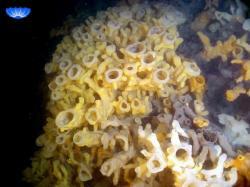OF THE
TIMES
The new planet, spotted using the Hobby-Eberly Telescope at the McDonald Observatory in West Texas, circles its bloated parent star every 360 days and is located about 300 light-years away, in the constellation Perseus.
The red giant star is twice as massive and about 10 times larger than the sun. Its planet is about the size of Jupiter or larger and was discovered using the so-called wobble technique, in which astronomers look for slight wiggles in a star's motion created by the gravitational tug of orbiting planets.

|
| ©Unknown |
| The SLU/Peking chimneys are 1.43 billion years old, the oldest such discovery on record, with previous findings dating back about 500 million years. |

|
| ©University of Victoria |
| Glass sponges are up to 50 centimetres high, and can build reefs up to 450 cm tall. |